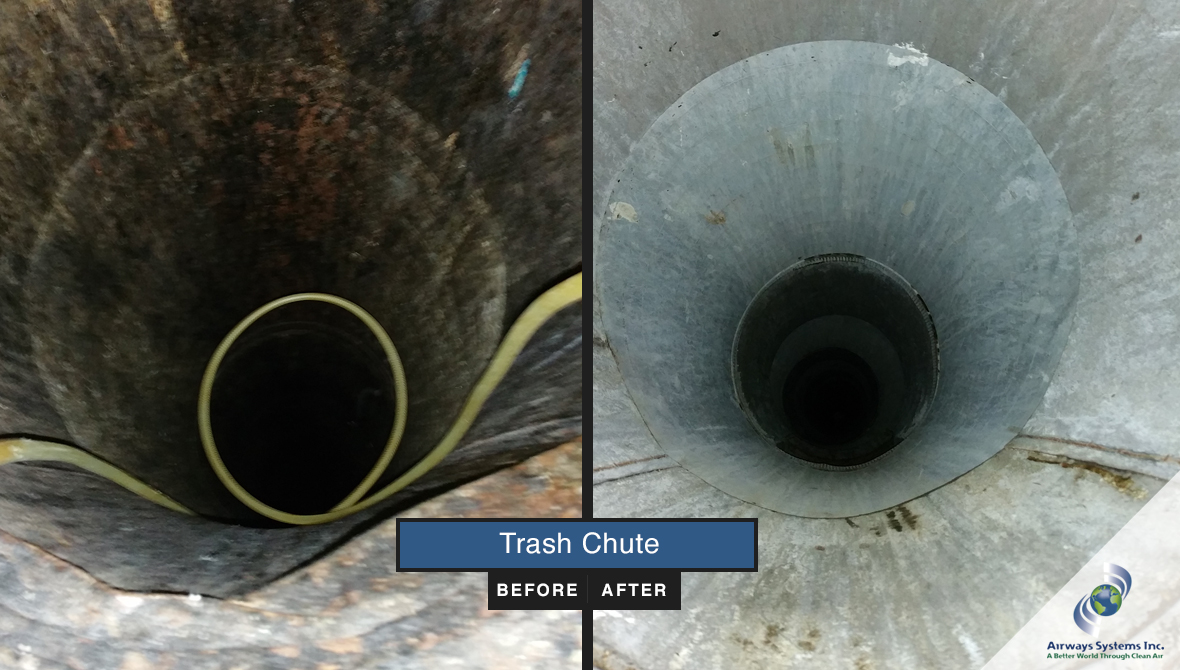Why Trash Chute Cleaning Matters:
-
Protect Air Quality and Health
Dirty trash chutes pose significant health hazards, especially in airtight commercial and residential buildings. Over time, they can become breeding grounds for bacteria, mold, and other harmful microorganisms that degrade indoor air quality. These contaminants can circulate through ventilation systems, potentially leading to respiratory issues, allergic reactions, and other serious health problems. Additionally, unclean chutes attract pests like flies and rodents, further increasing the risk of disease. Professional trash chute cleaning is essential to reduce these airborne hazards and protect the health of building occupants.
-
Prevent Odors, Pests, and Fire Hazards
Neglected garbage chutes lead to foul odors, pest infestations, and even dangerous grease fires. Accumulated waste residue becomes a breeding ground for rodents, cockroaches, and bacteria. Regular trash chute cleaning prevents these issues and keeps your building in top shape.
How Often Should Trash Chutes Be Cleaned?
Most buildings should have their trash chutes cleaned at least 1–2 times per year. High-rise buildings or properties with high trash volume (hotels, schools, universities, restaurants, etc.) may require more frequent service. Routine trash chute cleaning ensures cleanliness, safety, and compliance with local health regulations.
Benefits of Routine Chute Maintenance & Repair:
-
Extend Equipment Lifespan
Grease buildup and debris can cause excessive wear on your compactor and chute system. Routine cleaning and maintenance keep everything functioning efficiently and reduce costly repairs down the line.
-
Ensure Building Safety & Cleanliness
A well-maintained trash chute system boosts tenant satisfaction, lowers emergency maintenance calls, and helps property managers stay ahead of issues before they escalate.
Chicagoland’s Trusted Trash Chute Cleaning Company
Serving High-Rise Buildings, Condos, Hotels & More
Airways Systems has been the go-to provider for commercial trash chute cleaning in the Chicagoland area. We serve properties of all sizes; from residential towers to hospitals, hotels, and universities, with professional service you can count on.
Find Trash Chute Cleaning Near You!
Looking for trash chute cleaning companies near me? We offer quick response times, comprehensive chute inspections, and professional maintenance for buildings across Chicagoland.
Contact us today to schedule service.
Frequently Asked Questions About Trash Chute Cleaning (FAQ):
1. How do you clean a garbage chute?
We use specialized high-pressure steam equipment and eco-friendly disinfectants to clean, sanitize, and deodorize each chute from top to bottom.
2. How long does a cleaning service take?
Most buildings are completed in a few hours depending on the number of floors and chute length. We schedule at your convenience to minimize disruption.
3. Do you offer trash chute repair services?
Yes. In addition to cleaning, we offer chute door replacements, alignment adjustments, compactor servicing, and deodorizer systems.
4. Is trash chute cleaning required by law?
Yes. Local health codes (Section 518) recommend or require regular chute cleaning in multi-unit buildings to prevent health and fire risks. Per Section 518, "...All garbage and refuse shall be collected, stored, and disposed of in a manner that will not permit the transmission of a contagious disease, create a nuisance or fire hazard, or provide a breeding place for vermin or rodents.".
